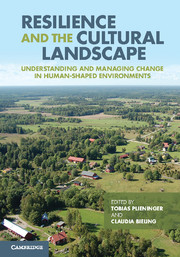 Resilience and the Cultural Landscape
Resilience and the Cultural Landscape Book contents
- Frontmatter
- Contents
- List of contributors
- Preface
- Part I Conceptualising landscapes as social–ecological systems
- Part II Analysing landscape resilience
- Part III Managing landscapes for resilience
- 12 Collective efforts to manage cultural landscapes for resilience
- 13 Response strategy assessment: a tool for evaluating resilience for the management of social–ecological systems
- 14 Ecosystem services and social–ecological resilience in transhumance cultural landscapes: learning from the past, looking for a future
- 15 The role of homegardens in strengthening social–ecological resilience: case studies from Cuba and Austria
- 16 Promises and pitfalls of adaptive management in resilience thinking: the lens of political ecology
- Part IV Perspectives for resilient landscapes
- Index
- References
13 - Response strategy assessment: a tool for evaluating resilience for the management of social–ecological systems
Published online by Cambridge University Press: 05 November 2012
- Frontmatter
- Contents
- List of contributors
- Preface
- Part I Conceptualising landscapes as social–ecological systems
- Part II Analysing landscape resilience
- Part III Managing landscapes for resilience
- 12 Collective efforts to manage cultural landscapes for resilience
- 13 Response strategy assessment: a tool for evaluating resilience for the management of social–ecological systems
- 14 Ecosystem services and social–ecological resilience in transhumance cultural landscapes: learning from the past, looking for a future
- 15 The role of homegardens in strengthening social–ecological resilience: case studies from Cuba and Austria
- 16 Promises and pitfalls of adaptive management in resilience thinking: the lens of political ecology
- Part IV Perspectives for resilient landscapes
- Index
- References
Summary
Introduction
In this chapter our intent is to present a method – response strategy assessment – for evaluating the resilience of social–ecological systems. We will describe how key features of social–ecological resilience can be used as a basis for a simple and generic analytical tool. This method uses empirical observations of stakeholder actions, qualitative or quantitative, as input data.
We begin with a review of recent thinking concerning resilience-orientated approaches to landscape management, making important distinctions among three responses to disturbance: coping, adapting and strategic transformation. We define and classify ecosystem services as they apply to landscapes, paying particular attention to how the ecological scales (where services are generated) may or may not coincide in space or time with the social scales where stakeholders receive benefits.
We combine all of these notions in the application of response strategy assessment in a cultural landscape in southern Sweden. We conclude that the method is a simple application of resilience concepts, with potential for use in a variety of cultural landscapes and management situations.
Resilience-orientated approaches to landscape management
Resilience-orientated approaches to landscape management are concerned with how systems respond to disturbance. A disturbance may come in different forms, such as stress driven by slow-changing variables or as shocks related to fast-changing variables.
Resilience is simultaneously dependent on the nature of the drivers that exert stress or shock and on the nature of the system under influence of this disturbance. A system with few properties that support resilience may be very persistent in a stable environment with few and mild disturbances. Likewise, a system with properties that contribute to robustness, sturdiness, etc. would not be resilient in an overly hostile environment. One needs to explore both the properties of disturbances as well as those of the system to estimate the resilience of a particular system.
- Type
- Chapter
- Information
- Resilience and the Cultural LandscapeUnderstanding and Managing Change in Human-Shaped Environments, pp. 224 - 241Publisher: Cambridge University PressPrint publication year: 2012
References
- 1
- Cited by


